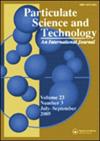倾斜水力输送管内粗颗粒流及其能量耗散
IF 1.5
4区 工程技术
Q3 ENGINEERING, CHEMICAL
引用次数: 0
摘要
在工业生产过程中,经常会遇到斜管中含粗颗粒流。采用考虑各种流体-颗粒间相力和湍流-颗粒相互作用的全耦合CFD-DEM模型模拟了粗颗粒在倾斜管道中的运移。能量耗散从宏观和微观两个角度进行了计算。分析了管道倾角、颗粒浓度、输送速度和颗粒直径对水力输送特性和能量耗散的影响。结果表明:随着倾角的增大,沉积颗粒逐渐分散;压降和能量耗散在60°时达到峰值。随着60°斜管内颗粒浓度和输送速度的增加,这两个参数均增大。能量耗散主要来源于湍流耗散、壁面摩擦、平均速度场和粒子重力。结果进一步表明,由于颗粒分布引起的流体内部调制可以显著改变速度波动引起的能量耗散,从而在60°处产生最大的压降和能量耗散。颗粒-流体能量耗散随输送速度的增加几乎呈线性增加,而随倾角和颗粒参数的增加呈非线性变化。关键词:液固流动cfd - dem方法能量耗散粗颗粒流倾斜管感谢国家自然科学基金、江苏省重点研发项目和江苏省杰出青年科学基金的资助。披露声明作者未报告潜在的利益冲突。作者感谢中国国家自然科学基金资助项目[批准号:No. 5]。: 52176038和51979125),江苏省重点R & D项目(批准号[项目编号:BE2021073]、江苏省杰出青年科学基金资助项目[批准号:2018202020773];BK20211547]。本文章由计算机程序翻译,如有差异,请以英文原文为准。
Coarse particle-laden flows and energy dissipation in inclined hydraulic conveying pipes
AbstractCoarse particle-laden flows in inclined pipes are commonly encountered in a wide range of industrial processes. A fully coupled CFD-DEM model considering various fluid-particle interphase forces and turbulence-particle interactions is used to simulate coarse particles transported in inclined pipes. The energy dissipation is calculated from both the macro and micro perspectives. The effects of pipe’s inclination angle, particle concentration, conveying speed and particle diameter on the hydraulic transport characteristics and the energy dissipations are analyzed. The results showed that, with the increase in inclination angle, the deposited particles were gradually dispersed. Pressure drop and energy dissipation displayed a peak at 60°. Both the parameters increased with the increases in particle concentration and conveying speed in 60° inclined pipe. The energy dissipation was mainly due to the turbulent dissipation, wall friction, mean velocity field and particles’ gravity. The results further showed that the modulations in the fluid due to particle distribution could significantly change the energy dissipation caused by the fluctuating velocity, thus resulting in the maximum pressure drop and energy dissipation at 60°. The particle-fluid energy dissipation increased almost linearly with the increase in conveying speed, while it varied nonlinearly with the increase in inclination angle and particle parameters.Keywords: Liquid-solid flowCFD-DEM methodenergy dissipationcoarse particle-laden flowinclined pipe AcknowledgementsThe authors are grateful for the financial support provided by the National Natural Science Foundation of China, Key R & D Projects in Jiangsu Province and Jiangsu Provincial Science Fund for Distinguished Young Scholars.Disclosure statementNo potential conflict of interest was reported by the author(s).Additional informationFundingThe authors are grateful for the financial support provided by the National Natural Science Foundation of China [Grant No.: 52176038 and 51979125], Key R & D Projects in Jiangsu Province [Grant No.: BE2021073] and Jiangsu Provincial Science Fund for Distinguished Young Scholars [Grant No. BK20211547].
求助全文
通过发布文献求助,成功后即可免费获取论文全文。
去求助
来源期刊

Particulate Science and Technology
工程技术-工程:化工
CiteScore
4.40
自引率
4.00%
发文量
86
审稿时长
12 months
期刊介绍:
Particulate Science and Technology, an interdisciplinary journal, publishes papers on both fundamental and applied science and technology related to particles and particle systems in size scales from nanometers to millimeters. The journal''s primary focus is to report emerging technologies and advances in different fields of engineering, energy, biomaterials, and pharmaceutical science involving particles, and to bring institutional researchers closer to professionals in industries.
Particulate Science and Technology invites articles reporting original contributions and review papers, in particular critical reviews, that are relevant and timely to the emerging and growing fields of particle and powder technology.
 求助内容:
求助内容: 应助结果提醒方式:
应助结果提醒方式:


